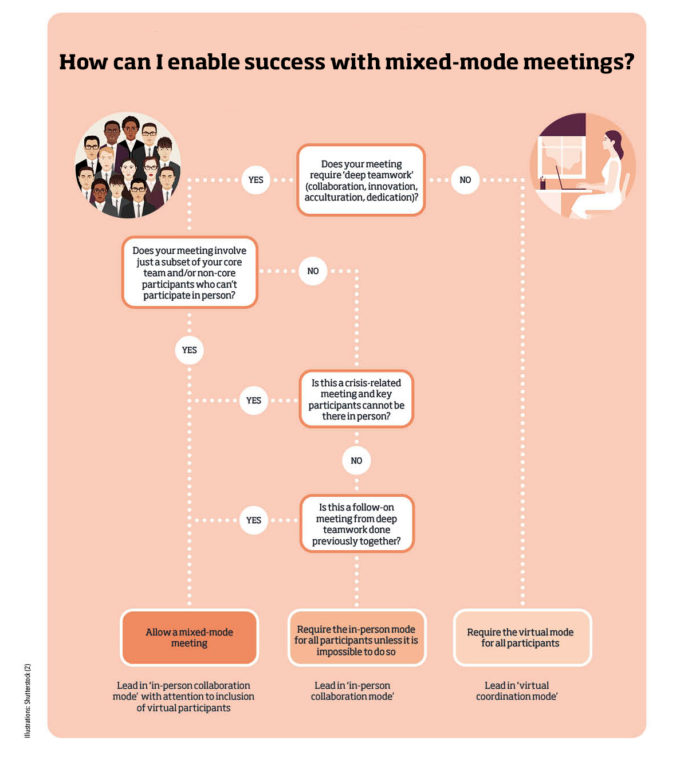
How elixir of longevity will alter life as we know it
Aging is now seen as a modifiable biological process. Longevity science is reshaping healthcare, careers, and society for longer, healthier lives....
Audio available

by Robert Hooijberg, Michael D. Watkins Published September 17, 2021 in Human Resources • 2 min read
Much of the conversation about hybrid work focuses on striking the right balance between the in-person and virtual modes. And we, too, have begun to explore the differences in how leaders need to support teamwork in the in-person and virtual modes. However, it’s increasingly clear that there is a third option – mixed-mode meetings – that presents additional challenges.
By mixed-mode, we mean meetings in which some participants are together physically while others are virtual. How should leaders balance the potential benefits of having some people present in person against the potential costs of diminished inclusion, connection, and influence for the virtual team members?
We started with the principle that mixed-mode meetings should happen only when they create concrete business value, and when it’s really not possible for the team to be together fully.
Here is our guide to how to decide whether and when to allow mixed mode meetings. This chart will help you decide when to schedule a meeting in person, when a Zoom meeting will suffice, and how to help people collaborate in hybrid gatherings.


Professor of Organizational Behaviour at IMD
Robert Hooijberg is Professor of Organizational Behavior at IMD. His areas of special interest are leadership, negotiations, team building, digital transformation, and organizational culture. Before joining IMD in September 2000, Professor Hooijberg taught at Rutgers University in their MBA and Executive MBA programs in New Jersey, Singapore, and Beijing. He is Program Director of the Breakthrough Program for Senior Executives and the Negotiating for Value Creation course.

Professor of Leadership and Organizational Change at IMD
Michael D Watkins is Professor of Leadership and Organizational Change at IMD, and author of The First 90 Days, Master Your Next Move, Predictable Surprises, and 12 other books on leadership and negotiation. His book, The Six Disciplines of Strategic Thinking, explores how executives can learn to think strategically and lead their organizations into the future. A Thinkers 50-ranked management influencer and recognized expert in his field, his work features in HBR Guides and HBR’s 10 Must Reads on leadership, teams, strategic initiatives, and new managers. Over the past 20 years, he has used his First 90 Days® methodology to help leaders make successful transitions, both in his teaching at IMD, INSEAD, and Harvard Business School, where he gained his PhD in decision sciences, as well as through his private consultancy practice Genesis Advisers. At IMD, he directs the First 90 Days open program for leaders taking on challenging new roles and co-directs the Transition to Business Leadership (TBL) executive program for future enterprise leaders, as well as the Program for Executive Development.

December 4, 2025 • by Jennifer Borrer, Saule Serikova in Human Resources
Aging is now seen as a modifiable biological process. Longevity science is reshaping healthcare, careers, and society for longer, healthier lives....
 Audio available
Audio available
October 2, 2025 • by Bülent Gögdün in Human Resources
In the face of burnout, quiet quitting, and workplace complexity, happiness is one often overlooked factor that can transform leadership resilience and team performance....
 Audio available
Audio available
September 2, 2025 • by Rachel Lewis in Human Resources
Learn how the PAR approach empowers employees to co-create solutions, reduce workplace stress, and improve well-being through data-driven action....

August 15, 2025 • by Ginka Toegel in Human Resources
As AI grows more capable, HR leaders must carefully weigh its impact on team dynamics before treating it as just another teammate, says IMD’s Ginka Toegel....
Explore first person business intelligence from top minds curated for a global executive audience